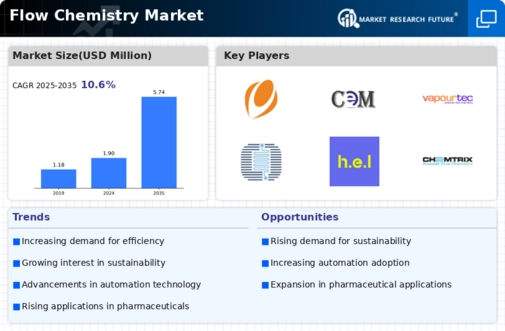Market Share
Flow Chemistry Market Share Analysis
In the rapidly evolving field of flow chemistry, market share positioning strategies are crucial for companies aiming to establish a strong foothold in the industry. One of the primary strategies employed is product differentiation. Companies strive to differentiate their offerings by focusing on unique features, such as enhanced performance, greater efficiency, or specialized applications. By highlighting these distinct advantages, companies can attract customers looking for specific solutions and thereby capture a portion of the market share. Moreover, differentiation allows companies to establish a competitive edge, making it harder for competitors to replicate their offerings and penetrate their market segment.
Cost leadership is another vital strategy utilized in the flow chemistry market. Companies aim to produce flow chemistry systems and equipment at a lower cost compared to competitors while maintaining acceptable quality standards. This enables them to offer competitive pricing, which appeals to cost-conscious customers and helps in gaining market share. Cost leadership strategies often involve optimizing manufacturing processes, sourcing materials efficiently, and leveraging economies of scale to drive down production costs. By offering cost-effective solutions without compromising quality, companies can attract a broader customer base and expand their market share.
Market segmentation is essential for effective market share positioning in the flow chemistry industry. Companies divide the market into distinct segments based on factors such as application areas, end-user industries, or geographic regions. By understanding the unique needs and preferences of each segment, companies can tailor their products, marketing strategies, and distribution channels to better serve targeted customer groups. This targeted approach enables companies to penetrate specific market niches more effectively, leading to increased market share within those segments.
Strategic partnerships and alliances also play a significant role in market share positioning within the flow chemistry market. Collaborating with other companies, research institutions, or academic organizations can provide access to complementary technologies, expertise, or resources that enhance competitiveness and market penetration. Joint ventures, licensing agreements, or strategic alliances can facilitate market expansion and strengthen market position by combining strengths and sharing risks. By leveraging strategic partnerships, companies can access new markets, expand their product portfolio, and enhance their overall market share.
Innovation and continuous product development are critical components of market share positioning strategies in the flow chemistry market. Companies invest in research and development to introduce new and improved flow chemistry solutions that address evolving customer needs, industry trends, and regulatory requirements. Innovation allows companies to stay ahead of competitors by offering cutting-edge technologies, advanced functionalities, and enhanced performance. By continuously innovating and upgrading their product offerings, companies can attract customers seeking the latest advancements and secure a larger share of the market.
Effective marketing and branding are essential for communicating the value proposition of flow chemistry solutions and influencing customer perceptions in the market. Through targeted marketing campaigns, branding initiatives, and promotional activities, companies can raise awareness about their products, build brand recognition, and establish a strong market presence. By effectively communicating the benefits and advantages of their flow chemistry solutions, companies can attract potential customers and gain market share over time.
Lastly, companies in the flow chemistry market must continually monitor market dynamics, competitor activities, and customer feedback to adapt and refine their market share positioning strategies. By staying informed about industry trends, customer preferences, and competitive landscape changes, companies can identify emerging opportunities and threats. This enables them to adjust their strategies accordingly, seize opportunities for growth, and mitigate risks that could affect their market share. Continuous market monitoring and strategic agility are essential for maintaining a competitive edge and sustaining market share in the dynamic flow chemistry market landscape.









Leave a Comment